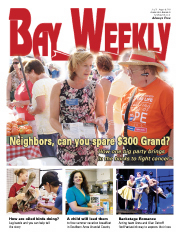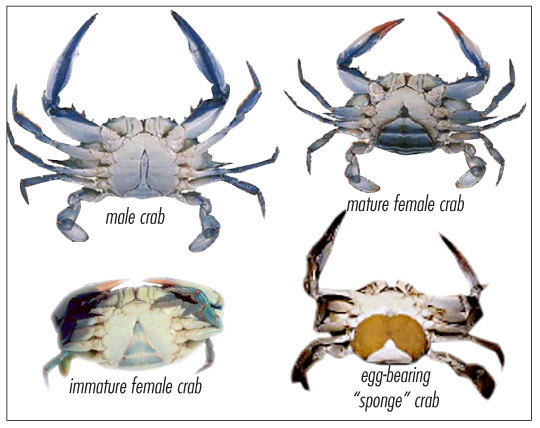Chesapeake Bay's Independent Newspaper ~ Since 1993
1629 Forest Drive, Annapolis, MD 21403 ~ 410-626-9888
Volume xviii, Issue 30 ~ July 29 - August 4, 2010
Home \\ Correspondence \\ from the Editor \\ Submit a Letter \\ Classifieds \\ Contact Us
Best of the Bay \\ Dining Guide \\ Home & Garden Guide \\ Archives \\ Distribution \\ Advertising![]()


Save the Sooks
Female blue crabs need our protection
It’s beginning to look like business as usual with the Chesapeake’s most treasured natural resource, the blue crab. Maryland is on course to resume the destructive harvest of female crabs, sooks, with its first official act upon the arrival of news that the crab population has at last begun to rebound.
At the brink of species collapse two years ago, our crab population has shown a 60 percent increase in only two seasons after the first significant reduction of female harvest. There should be little doubt at this point that protecting females is the most critical factor in rebuilding our blue crab populations.
The steady and nearly disastrous decline of the state’s beloved and delicious crustacean had been blamed on many things over the years: pollution; loss of Bay grasses; too many rockfish; agricultural runoff; stormwater runoff; and then, quite possibly — the over-harvest of females.
Historically, the taking of females was sanctioned and based on research concluding that the harvest of mature females had little effect on overall crab population, even though common sense and much public opinion indicated otherwise. 
With the crab population dropping to critical levels, more research cast doubt on the original science. This year it has become crystal clear that the wholesale harvest of female crabs was suicidal for the species.
Now, immediately after the first indication of recovery (due obviously to the increase in females), Maryland intends to again expand the female harvest. It is suspending a nine-day commercial closure that was part of the original program of restrictions.
This is not an overwhelming resumption of our previously destructive practices. Nonetheless, it is a disturbing gesture.
If I’m not mistaken, the Chesapeake Bay blue crab is a public resource. The management of that resource is intended, by law, to benefit everyone. Shouldn’t our state be focusing on rebuilding and maintaining an optimum population of blue crabs as quickly as possible, especially given our recent brush with species disaster?
To me it’s common sense that once a larger biomass of crabs was achieved — a population large enough to be overwhelmingly safe from collapse — abundance would benefit us all, commercial watermen included, and the sooner the better.
Commercial-sector incomes are already increasing due to current crab population growth and will continue to expand as long as the crab population grows. But that sector is yearning to resume harvesting females — even though it is the very practice that led to population collapse in the first place.
Maryland officials appear to be eager to cooperate.
Natural resource management calls for hard decisions to protect our resources. An election year makes hard decisions even harder. But the blue crab deserves more from Maryland. They deserve to flourish. Protect female blue crabs. They are key to a better future for the Chesapeake.
Fish Are Biting
Rockfishing remains productive for anglers able to present the right-sized spot to the right school of stripers. Live-lining is the method of choice on the Western Shore from Podickery down to Thomas Point.
A surface bite on breaking schools of rock and blues continues into its second month on the Eastern Bay, with massive schools of baitfish providing the attraction for the stripers and blues. A top-water bite on the Western side is developing as well, but slowly. The occasional striper of six to seven pounds is being taken on poppers and chuggers in and around skinny-water structures at early morning and late afternoon.
White perch are crowding the shallows as well and in larger sizes and greater numbers on the Western Shore than have been seen in some time. Spinner baits, Beetle Spins and other small lures are resulting in impressive catches of these delicious fish. Large croaker, up to 18 inches or more, are being found in 30 feet of water over shell bottoms at channel edges, especially in the evening and into the night. They are taking bait shrimp and bloodworms.
The recent superb crabbing dropped off with the heat wave and the arrival of hordes of smaller crabs, more than I’ve ever seen. In one instance, 400 to 500 small crabs were showing up on a trotline run with just 250 baits. They were so numerous as to drive off the larger jimmies and eat all the baits. This phenomenon can be irritating, but the thought of these numbers of crabs reaching maturity next season is mind-boggling. Perhaps this year’s already-great crabbing season is just the start of something even greater if the politicians can resist giving the store away.
© COPYRIGHT 2010 by New Bay Enterprises, Inc. All rights reserved.
